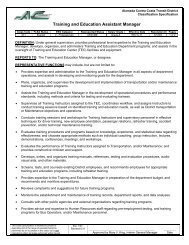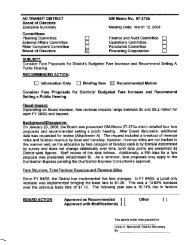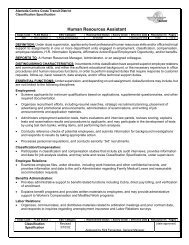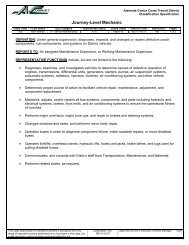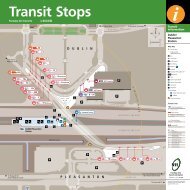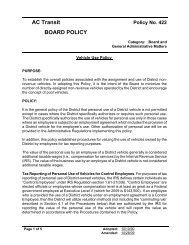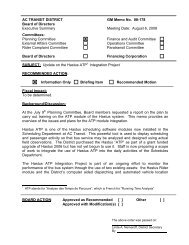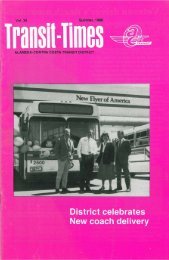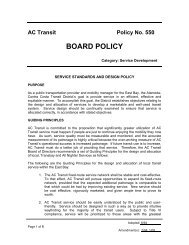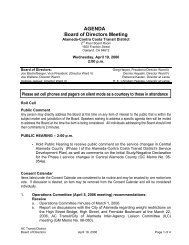AC TRANSIT DISTRICT GM Memo No. 06-228 Board of Directors ...
AC TRANSIT DISTRICT GM Memo No. 06-228 Board of Directors ...
AC TRANSIT DISTRICT GM Memo No. 06-228 Board of Directors ...
You also want an ePaper? Increase the reach of your titles
YUMPU automatically turns print PDFs into web optimized ePapers that Google loves.
<strong>GM</strong> <strong>Memo</strong> <strong>No</strong>. <strong>06</strong>-<strong>228</strong><br />
Subject: Proposed Outline <strong>of</strong> Revised Policy 550<br />
Date: October 4, 20<strong>06</strong><br />
Page 11 <strong>of</strong> 12<br />
• Funding Hierarchy – Supplemental Services are funded separately using either<br />
fares, grants or through other funding mechanisms.<br />
Application <strong>of</strong> Standards<br />
To determine service effectiveness, staff will conduct ridership surveys on a regular<br />
basis, either through manual counts or automated systems. The information that is<br />
collected will be used to determine planning metrics such as passengers per in-service<br />
hours, load factors and the overall ranking <strong>of</strong> the services.<br />
Annually, <strong>AC</strong> Transit staff will provide the <strong>Board</strong> <strong>of</strong> <strong>Directors</strong> with an assessment <strong>of</strong><br />
route performance within the service categories, including frequency, span and load<br />
factor. Transit lines will be ranked by passengers per in-service hour. Pursuant to<br />
federal guidelines, minority transit routes will also be identified. Services falling below<br />
the 25th percentile <strong>of</strong> all routes within the specific category will be analyzed, and<br />
responses may include any <strong>of</strong> the following:<br />
• Schedule adjustments, if service frequencies are more generous than required<br />
by Policy.<br />
• Running time adjustments or minor route changes, to provide substantially the<br />
same level <strong>of</strong> service while reducing operating costs and retaining most<br />
passengers.<br />
• Route improvements, including route consolidation or through-routing to improve<br />
efficiency and effectiveness.<br />
• Equipment changes necessary to increase capacity and reduce crowding as load<br />
factors reach LOS F.<br />
• Route discontinuance, should there be no other means to improve efficiency or<br />
provide a well-used transit product.<br />
During this annual evaluation, staff will also provide the <strong>Board</strong> with a listing <strong>of</strong> corridor<br />
segments qualifying as “Trunk Routes and Major Corridors.” The listing will be by<br />
segments <strong>of</strong> one to two miles in length. From this listing, staff will present a graphic<br />
showing all the route segments that meet the threshold <strong>of</strong> “Trunk Routes and Major<br />
Corridors,” both from a land use criteria perspective and a transit use perspective.<br />
Policy Issues For <strong>Board</strong> Consideration:<br />
• Shall the District adopt the LOS metrics (A to F rankings, described above) as a<br />
part <strong>of</strong> Policy 550?<br />
• The Hastus scheduling upgrade, now in process, will ultimately provide<br />
Scheduling staff with the tools to achieve additional savings via the scheduling




